This display piece could be seen in Mattel’s 1986 retailer catalog. It was designed to hold 144 4-packs inside of a wrestling ring type enclosure.
Mattel needed to make an unfamiliar product familiar, and the Pre-Pack did this with wrestling and monsters. The wrestling ring was an instantly identifiable object that would hopefully draw attention. Wrestling’s popularity was growing and reaching new heights. Arguably professional wrestling would reach an all-time high with Wrestlemania III in March of 1987. It would feature Andre the Giant and Hulk Hogan in a match that penetrated pop-culture. Wrestling would hopefully interest some children. The monsters might attract other children.
The art of the M.U.S.C.L.E. pre-pack is 100% unique. These images are not seen on any other M.U.S.C.L.E. item. The characters on the Pre-Pack seem to be carefully considered.
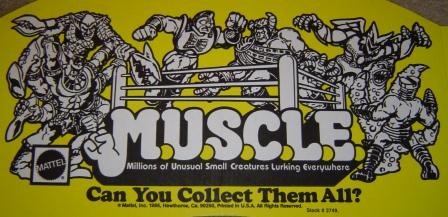
Pre-Pack: Arch Art
Seven of the eight unique images are on the arch above the ring. The first figure (moving left to right) is Ashuraman, a muscular six-armed humanoid. This large figure fills the left side of the picture, and allows for excellent interaction with the next character.
There is some debate as to the official name of the second character. Both Kyoaku Chojin and Villainous Chojin are widely accepted. Here Mattel has chosen to highlight a humanoid-type figure with claws. While the figure has a monster quality, it is still recognizable as humanoid. It allows for fantasy without being unrecognizable to a child.
In the center of the picture are the flagship characters for Mattel. On the left, the hero, Kinnikuman. Mattel chose to rename this figure Muscleman. On the right, the villain, Buffaloman. Again, Mattel chose to rename this figure Terri-Bull. Both of these figures appear to be humans with fantastic costumes.
The fifth figure is Condora. This humanoid figure is clearly bird-like. Mattel seemed to be very conscious that children needed to be intrigued by the figures, but not alienated but unrecognizable monsters. Each monster/animal-like figure is has a very human shape.
The sixth figure, arguably the most poplar M.U.S.C.L.E. figure, is Sunigator – more commonly known as The Claw. With this selection Mattel goes against the grain. This figure is pure fantasy. It is a monster is the shape of a four fingered hand. The appeal of this figure is clearly universal. The artist liked it, Mattel liked it, and children loved it.
The last figure is Screw Kid. Unfortunately this humanoid figure partially obscures Sunigator. This is the only character with their back to the viewer. There seems to be a simple explanation for this choice. Screw Kid does not have an interesting face and it allows for interaction with Sunigator. Additionally, the Screw Kid figure does not lose any visual appeal when viewed from behind.
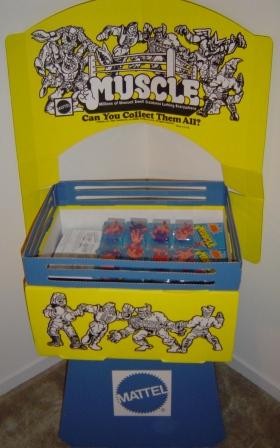
Pre-Pack: Complete Front View
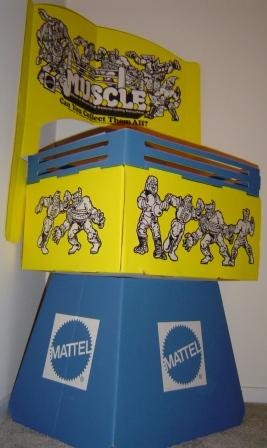
Pre-Pack: Complete Front and Side
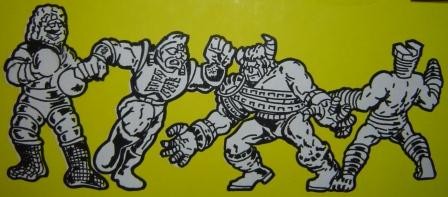
Pre-Pack: Front Panel of Wrestling Ring
Apollo the Giant seems to be a remnant from the original vision of the Pre-Pack. In the 1986 Mattel catalog a Pre-Pack can been seen. Seemingly Apollo the Giant was originally on the left side of the arch, along with another unidentifiable figure on the right side. These two figures were probably cropped out of the picture for one or both reasons: (1) to allow for a larger image to appear on the arch; and/or (2) the measurement of the arch changed during production.
A comparison of the actual Pre-Pack and the catalog version showcase some of the differences.
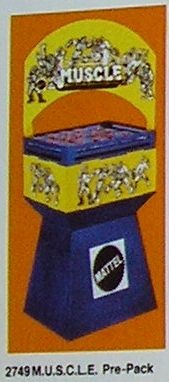
Pre-Pack: 1986 Catalog Picture
This also highlights the difference in the arch. The catalog arch was continuous, like a rainbow from side to side. The final production version was more like a setting sun, with an arch that connected to a flat horizon.
The logos are the final noticeable difference. The catalog version did not include the tagline of “Can You Collect Them All?” which was included on the final production version. The Mattel logo on the arch of the catalog version appears to be further to the left than on the production version. And finally, the Mattel logo on the base is black, unlike the blue logo on the production version.
The catalog version also has the arch going across the ring diagonally, unlike the UofM pictures. This is not a difference between the production and catalog versions. This was a result of the production version being too delicate to completely re-build as instructed.
Mattel provided explict details for the construction of the Pre-Pack.
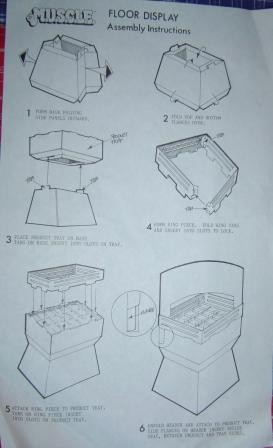
Pre-Pack: Instructions
This display could have been as tall, or taller, than some of its target market. The entire display is roughly four feet tall when completely assembled. The bottom stand is 19” wide, 15” long, and 15” high. The bottom tapers up to the base (which holds the wrestling ring) and is 10” wide, 14” long, and 6” high. The wrestling ring holding the figures is 15” wide, 19” long, and 9” high, and the ropes surrounding the ring are 3” high. Tthe arch is 28” wide and 16” high.
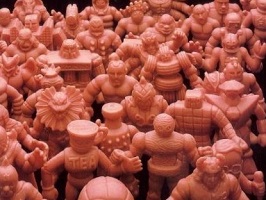
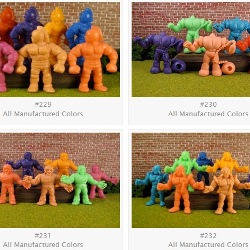
#1 by Ridureyu on July 7, 2011 - 9:49 pm
Is there any way we can see some high-resolution pictures of the artwork? it honestly looks pretty nice. Desktop-worthy, even.
#2 by Dylan on March 13, 2018 - 1:51 am
This is incredible.